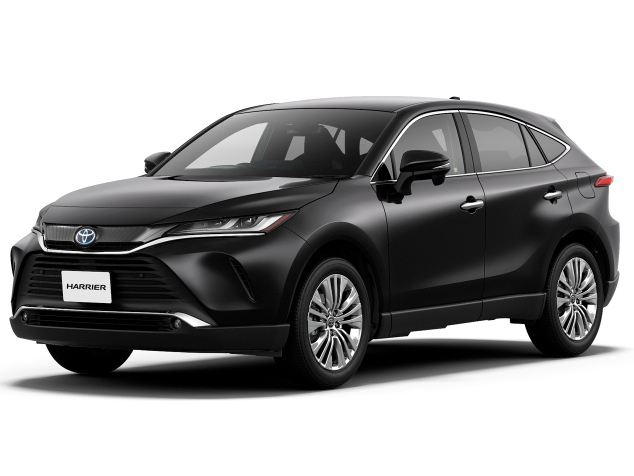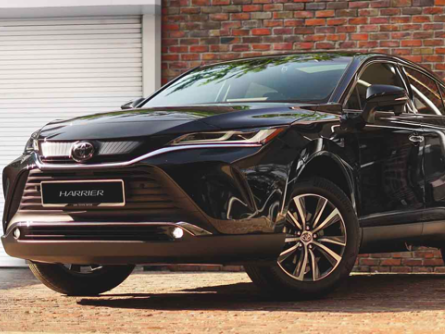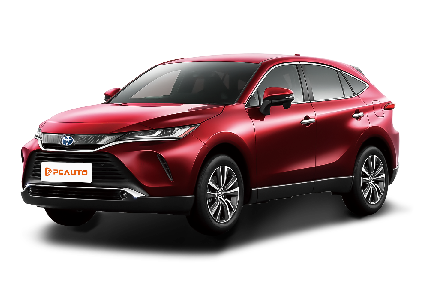Q
What is the Toyota Harrier Specs? Here's the Full Specifications
The Toyota Harrier is a D-segment vehicle available in multiple different versions. Its body length is approximately 4,725 - 4,740mm, width around 1,835 - 1,855mm, height about 1,660 - 1,690mm, wheelbase is roughly 2,660 - 2,690mm, and the vehicle weight is about 1,610 - 1,705kg. All models feature a 5-door, 5-seater design, with a fuel tank capacity of about 55 - 60L.
In terms of power, the intake forms include naturally aspirated (NA) and turbocharged (Turbo), and most of the engine displacements are 2.0L. The naturally aspirated engine has a maximum horsepower of 173PS, a maximum power of 127.2kw, and a maximum torque of 203N·m. The turbocharged engine has a maximum horsepower of 231PS, a maximum power speed of 5,200rpm, and a maximum torque speed of 1,650rpm. The transmission types are CVT and AT, and all models are front-wheel drive.
Regarding safety features, standard equipment includes ABS anti-lock braking, vehicle stability control, lane change assist, lane departure warning, and active braking. There are usually 7 airbags. Comfort and technology features include a multi-functional steering wheel, automatic air conditioning, LED headlights, rain-sensing wipers, and a central control touchscreen. Different versions vary in price and some configuration details. For example, the 2023 Toyota Harrier 2.0 Luxury is priced at RM 274,000, while the 2.0 Luxury SE is priced at RM 277,000. The latter comes with a 360-degree parking imaging system, whereas the former has rear cameras.
Special Disclaimer: This content is published by users and does not represent the views or position of PCauto.
Related Q&A
Q
How many types of Toyota Harriers 2023 are there?
In the Malaysian market in 2023, the Toyota Harrier is mainly available in two models: the Harrier 2.0 with a 2.0-liter naturally aspirated engine and the Harrier Hybrid 2.5 equipped with a 2.5-liter hybrid system. Both models feature front-wheel drive configuration. The Harrier 2.0 is suitable for consumers seeking a smooth driving experience, while the Harrier Hybrid attracts buyers who focus on energy-saving with its higher fuel efficiency and environmental-friendly features.
This fifth - generation Harrier is built on the TNGA-K platform. Its exterior design includes "eagle-eye" LED headlights and a through-type taillight. The interior is equipped with a 12.3 - inch touchscreen and a JBL audio system. The Toyota Safety Sense intelligent safety system comes as standard across the range, including functions such as pre-collision warning and lane-keeping assist.
It's worth noting that all Harriers in the Malaysian market are completely built-up (CBU) imports, so the prices are slightly higher than those of completely knocked - down (CKD) locally assembled cars. However, this also ensures the original factory quality. For consumers considering purchasing, it is recommended to choose the power version based on their daily driving mileage. If you often drive long distances, the hybrid version can significantly reduce fuel costs, while the 2.0 - liter version offers better cost - effectiveness for short - distance urban commuting.
Q
What is the life expectancy of a Harrier 2023?
In 2023, the normal service life of the Toyota Harrier in Malaysia can reach 15 to 20 years or cover a mileage of over 250,000 kilometers. The specific lifespan depends on maintenance conditions, driving habits, and road and environmental conditions. Regularly replacing key consumables such as engine oil, transmission fluid, and brake fluid and following the manufacturer's maintenance manual can significantly extend the vehicle's lifespan. As a mid - size SUV under the Toyota brand, the Harrier has a good reputation for its durability, thanks to its mature powertrain and reliable chassis design. The tropical climate in Malaysia has a certain impact on rubber parts and electronic components. It is recommended that car owners check the condition of suspension bushings and wiring harnesses every two years. At the same time, pay attention to anti-rust treatment of the chassis during the rainy season. For the hybrid version, special attention should be paid to the maintenance of the battery cooling system. Good driving habits, such as avoiding frequent rapid acceleration and hard braking, can also reduce mechanical wear. It's worth noting that there is a strong demand for well - maintained Harriers in the Malaysian used-car market, and they have a relatively high residual value. If you plan to use the vehicle for a long time, it is recommended to choose the original factory's extended warranty service for more comprehensive protection.
Q
Is the 2023 Toyota Harrier a 5 seater or 7 seater?
The 2023 Toyota Harrier in the Malaysian market is a 5-seater SUV, and no 7-seater version is available. This model focuses on luxury and comfort, featuring a two-row seat layout, which is suitable for family or individual users who pursue a refined driving and riding experience. As a mid-size SUV under Toyota, its body size and design emphasize rear-seat space and trunk practicality rather than a multi-seat configuration. If you need a 7-seater vehicle, you can consider other Toyota SUVs like the Fortuner or Innova. When Malaysian consumers choose an SUV, apart from the number of seats, they also need to consider the power configuration (for example, the Harrier offers 2.0L naturally aspirated and 2.5L hybrid options), fuel economy, and adaptability to local road conditions. The hybrid version of the Toyota Harrier is especially suitable for urban commuting, balancing performance and fuel consumption. Moreover, the automotive tax structure in Malaysia gives hybrid models a price advantage, which is also one of the reasons why the Harrier is popular locally.
Q
What is the safety rating of Harrier 2023?
In 2023, the Toyota Harrier excelled in terms of safety performance. According to the test results of the globally authoritative safety evaluation organization, ASEAN NCAP, this model received a 5-star safety rating. This rating covers multiple aspects such as adult occupant protection, child occupant protection, and safety assistance technologies, indicating its high standards in collision safety and active safety configurations.
The 2023 Harrier is equipped with Toyota's latest TSS (Toyota Safety Sense) active safety system, including functions like the pre - collision system, lane - keeping assist, and adaptive cruise control. These technologies can effectively enhance driving safety and reduce the risk of accidents. For Malaysian consumers, choosing a vehicle with a high safety rating is particularly important because the road traffic conditions in Malaysia are complex, and the safety performance of a vehicle is directly related to the lives of drivers and passengers.
In addition, the 2023 Harrier also features a high-rigidity body structure and multiple airbags, which further enhance passive safety protection. Understanding a vehicle's safety rating and configuration is an important reference when purchasing a car. It is recommended that consumers thoroughly understand relevant safety test reports and actual driving experiences before buying a car to ensure they choose the model that best suits their needs.
Q
What is the eco mode on a Toyota Harrier 2023?
The ECO mode of the 2023 Toyota Harrier is a driving assistance feature designed to improve fuel economy. It optimizes energy consumption by adjusting the engine output, the gear - shifting logic of the transmission, and the power consumption of the air - conditioning system. This mode is particularly suitable for the common urban congested traffic conditions in Malaysia.
When the ECO mode is activated, the vehicle reduces fuel consumption with a smoother acceleration response and an early up-shifting strategy. Meanwhile, the dashboard shows real-time energy-saving feedback to help drivers develop fuel-saving habits. This mode works in tandem with the Dynamic Force series 2.0L naturally-aspirated or 2.5L hybrid system equipped in the Harrier. The hybrid version can manage the alternation between the electric motor and the engine more efficiently in ECO mode.
For drivers who often face the morning and evening rush hours in Kuala Lumpur, the ECO mode can significantly reduce fuel consumption by about 10% - 15%. However, it should be noted that the power response may be temporarily weakened during sudden acceleration or on steep slopes. Similar features are also provided by models in the same class, such as the ECON mode of the Honda CR-V or the i-stop technology of the Mazda CX-5, but Toyota's hybrid system has an edge in energy management.
It is recommended that Malaysian car owners activate the ECO mode first when driving on long - distance trips or flat roads. When quick overtaking is needed or when driving on mountain roads, they can switch to the normal mode for a more direct power output.
Q
Is the 2023 Toyota Harrier a SUV or MPV?
The 2023 Toyota Harrier is an SUV (Sport Utility Vehicle), not an MPV (Multi - Purpose Vehicle). This vehicle is well- known for its stylish exterior design, high ground clearance, and comfort that caters to city driving. It's a great fit for Malaysian families, offering an excellent driving experience on both city roads and during occasional out-of-town trips.
The main differences between SUVs and MPVs lie in their body structures and uses. SUVs generally focus on driving visibility and off - road capability, while MPVs prioritize passenger space and seating capacity. As a five-seat SUV, the Harrier provides decent trunk space and elevated seat positions, making it a good choice for consumers who like the SUV style but don't want a large seven-seat model.
In the Malaysian market, the Harrier has become a popular option among many car buyers, thanks to the reliability of the Toyota brand and the fuel efficiency of its hybrid version, especially for those who seek both comfort and practicality. Moreover, it comes with a rich array of safety features, including Toyota's latest TSS (Toyota Safety Sense) system, which further enhances driving safety.
Q
Does 2023 Harrier have turbo?
In 2023, the versions of the Toyota Harrier available in the Malaysian market are indeed equipped with turbo-charged engines. Specifically, it's a 2.0-liter turbo-charged four-cylinder engine. This engine can deliver a power output of approximately 227 horsepower and a torque of 350 Nm, with quite excellent performance. Meanwhile, the car also offers a 2.5-liter naturally aspirated hybrid version, which is suitable for consumers who pursue fuel economy.
Turbocharging technology improves the engine's intake efficiency by compressing air, thus enhancing power without increasing the displacement. This technology is becoming more and more popular in modern cars, especially when it comes to meeting the requirements of both performance and environmental protection. For Malaysian consumers, choosing the turbo-charged version of the Harrier not only allows them to enjoy more powerful performance but also experience more responsive acceleration, which is very suitable for city driving and high-speed cruising.
In addition, Toyota's turbo-charged engines have a good reputation for reliability and durability, and the maintenance costs are relatively reasonable, making them suitable for long - term use. If you have high requirements for power, the turbo-charged version of the Harrier would be a good choice, while the hybrid version is more suitable for drivers who focus on energy conservation and environmental protection.
Q
What is the top speed of the Toyota Harrier 2023?
In 2023, the official maximum speed of the Toyota Harrier in the Malaysian market is approximately 180 km/h. This figure applies to the front-wheel drive or all - wheel drive versions equipped with a 2.0-liter naturally aspirated engine (171 hp). As for the hybrid models (2.5 liters + electric motor, with a combined output of 218 hp), due to the tuning of the powertrain and the setting of the electronic speed limit, their top-speed performance is similar.
It's worth noting that the actual top speed may be affected by factors such as road conditions, vehicle load, and climate. In the hot and humid environment of Malaysia's tropical rainforest climate, it is recommended that car owners regularly check the cooling system and tire condition to ensure safety during high - speed driving.
As a mid - size SUV focusing on luxury and comfort, the electronic speed-limit setting of the Harrier pays more attention to fuel economy and driving stability. The Toyota Safety Sense system it is equipped with will automatically optimize power output and braking assistance at high speeds.
If you have higher performance requirements, you can refer to the top - speed performance of peer models such as the Honda CR - V or the Mazda CX-5. However, it should be noted that the high-center-of-gravity design of SUVs inherently results in a lower speed limit compared to sedans in the same class.
It is recommended that car owners experience the top speed on legal race tracks or closed venues. The default speed limit on Malaysian highways is 110 km/h. Speeding is not only illegal but also significantly increases fuel consumption.
Q
Is 2023 Harrier 3 cylinder or 4 cylinder?
The 2023 Toyota Harrier available in the Malaysian market has a gasoline version equipped with a 2.0-liter four-cylinder naturally aspirated engine (model 3ZR-FAE), while the hybrid version features a combination of a 2.5-liter four-cylinder Atkinson cycle engine and an electric motor. Therefore, both the gasoline and hybrid versions come with a four-cylinder configuration, not a three-cylinder design. For Malaysian consumers, four-cylinder engines usually have an edge over three-cylinder ones in terms of smoothness and noise control. Meanwhile, Toyota's Dynamic Force series engines are well - known for their high thermal efficiency, which can balance power and fuel economy. It's worth noting that although there is a global trend in the automotive industry to reduce engine displacement and the number of cylinders, Toyota still adheres to the four - cylinder foundation in its mainstream SUV models to ensure driving quality and reliability. Three - cylinder engines are more commonly found in small cars or entry - level models. It is recommended that you take a test drive at an authorized dealer before buying a car to experience the performance differences of different powertrains in person.
Q
What is the engine of Harrier 2023?
In the Malaysian market in 2023, the Toyota Harrier offers two powertrain options, both of which adopt Toyota's well - established hybrid technology. Among them, the 2.5 - liter inline - four Dynamic Force engine paired with the THS II hybrid system is the main configuration. The combined output of this system can reach 222 horsepower. Coupled with the E - CVT transmission, it provides a smooth driving experience. At the same time, it has excellent fuel consumption performance. The official data shows that it can reach about 5.3L/100km, which is especially suitable for the congested urban traffic conditions in Malaysia. It's worth mentioning that the Harrier's hybrid system uses a nickel - metal hydride battery pack. Compared with lithium batteries, it is more adaptable to the tropical climate and shows good durability. For consumers who pursue power, a 2.0 - liter turbocharged version is also available in some markets, but currently, the hybrid version is the main offering in Malaysia. This engine uses the D - 4ST dual - injection technology, which balances power and fuel economy. Its technical principle is similar to that of the Lexus NX series, reflecting Toyota's modular development strategy. In terms of maintenance, Toyota has established a well - developed service system for its hybrid system in Malaysia. The battery pack usually comes with an 8 - year/100,000 - kilometer warranty, giving car owners more peace of mind.
Latest Q&A
Q
What is the CC of Honda City 2020?
The 2020 Honda City hits the Malaysian market with two engine choices: a 1.5-liter SOHC i-VTEC naturally aspirated petrol engine and a 1.5-liter DOHC i-VTEC hybrid system. Let's break down the specs. The petrol unit displaces 1497cc, cranking out 121 horsepower and 145 Nm of torque. On the hybrid side, it pairs that same 1.5-liter engine with an electric motor, resulting in a combined 109 horsepower – this one's all about fuel sipping efficiency.
Now, CC (cubic centimeters) is the measure of engine displacement, and it directly impacts how a car performs and drinks fuel. Typically, a bigger displacement means more power, but it can also mean higher fuel bills. The City's 1.5-liter sweet spot is a big reason it's so popular in Malaysia – it strikes that perfect balance between pep and fuel economy, handling both city commutes and longer drives like a champ.
But the 2020 City isn't just about the engine bay. It also comes loaded with Honda Sensing safety tech and a modern, fresh interior design, which really ups its game in the market. For Malaysian buyers, this car ticks all the boxes: practical, easy on the wallet at the pump, and packed with the latest tech. It's a solid all-rounder.
Q
How much does a Honda 2020 cost?
Prices for the 2020 Honda models in Malaysia vary quite a bit depending on the specific model and how it's kitted out. Take the Honda City, for example – you're looking at roughly RM70,000 to RM90,000. The Civic sits a bit higher, usually ranging from around RM110,000 up to RM140,000, while the CR-V typically falls between RM140,000 and RM170,000. exact figures hinge on the trim level, engine specs, and any extra add-ons you might go for.
When buying a new car in Malaysia, it's not just the sticker price you need to factor in. There's registration fees, insurance, road tax – all that extra stuff adds up and affects the final on-the-road cost.
Over in the used car market, 2020 Honda models will fluctuate in price too, based on mileage, condition, and remaining warranty. You can generally pick one up for 20% to 40% less than a brand-new equivalent.
If you're in the market, I'd definitely recommend shopping around different dealers to compare quotes. It's also worth checking out any ongoing Honda promotions or financing deals – those can really help you save some cash.
Hondas have a solid rep in Malaysia for being reliable and fuel-efficient, especially popular models like the City and Civic. They're pretty affordable to own long-term, and getting them serviced or repaired is relatively straightforward.
Q
What is the top speed of Honda City 2020?
The 2020 Honda City maxes out at around 190 km/h, which is the top speed you can squeeze out of its 1.5-liter i-VTEC naturally aspirated engine under ideal conditions. Of course, in the real world, you might see a slight difference depending on road conditions, how much you're carrying, or the weather. This car is pretty popular in the Malaysian market, and it's not just because of its solid performance—it's also about that fuel efficiency and nimble handling that makes city driving a breeze. The CVT gearbox in the City does a good job smoothing out power delivery, so acceleration feels seamless and efficient, whether you're commuting daily or hitting the highway for a longer drive. For Malaysian buyers, beyond just top speed, overall performance and maintenance costs matter a lot, and the City delivers here too. Its low trouble rate and wide service network make life easier for owners. If you're craving a bit more zip, there's always the Honda City RS variant. It gets some tweaks to the engine tuning and sportier bits, but don't expect a huge jump in top speed—these cars are all about balancing practicality with a bit of driving fun, after all.
Q
How safe is the Honda City 2020?
The 2020 Honda City holds its own when it comes to safety, packing in 6 airbags, Vehicle Stability Assist (VSA), Anti-lock Braking System (ABS), and Electronic Brake-force Distribution (EBD). That's a pretty solid setup for the class, and it should do a good job of keeping you protected during those daily drives around Malaysia. Honda's ACE Body Structure is also on board here, which is designed to effectively disperse crash energy and boost occupant safety in the event of a collision. It's worth highlighting that the 2020 City scored a 5-star rating in ASEAN NCAP crash tests, which is a solid stamp of approval for its safety credentials. For Malaysian buyers, picking this car means you're not just getting Honda's usual reputation for reliability, but also a decent level of safety kit. If safety is a top priority for you, it's definitely worth checking out the specific safety features when you're looking to buy – things like whether it comes with Honda Sensing. That suite includes handy advanced features like Adaptive Cruise Control and Lane Keeping Assist, which can go a long way in making your drives even safer.
Q
What is the fuel economy of the Honda City 2020?
The 2020 Honda City demonstrates excellent fuel efficiency in the Malaysian market. The variant equipped with the 1.5L i-VTEC petrol engine and CVT transmission has an official combined fuel consumption of 5.4 L/100km (approximately 18.5 km/L). The hybrid e:HEV variant is designed for even higher efficiency, though its specific fuel consumption figure should be verified with official sources or latest reviews, as the widely cited 3.4 L/100km (approximately 29.4 km/L) lacks direct support in the provided search results and may not reflect real-world conditions in Malaysia. Both powertrains closely align with the demands of Malaysian consumers who prioritize fuel economy. Actual fuel consumption may vary depending on factors such as driving habits, road conditions, and vehicle load. Therefore, adhering to a regular maintenance schedule is crucial for maintaining optimal fuel efficiency.
Given Malaysia's hot and humid climate, judicious use of the air conditioning system and maintaining the recommended tire pressure can contribute significantly to improving fuel economy. As a top-selling model in the B-segment sedan market in Malaysia, the Honda City's fuel efficiency remains competitive against its peers, making it a practical choice for daily commuting and family use. The e:HEV hybrid version, in particular, presents a compelling option for environmentally conscious drivers seeking to minimize long-term running costs, pending verification of its specific fuel economy claims.
View MoreRelated News

Toyota Harrier: The Perfect Blend of Fuel Efficiency and Premium Comfort
JamesApr 23, 2025

The 2023 Toyota Harrier is priced at RM 274,000, 2.0NA+CVT
LienJul 3, 2024

Toyota Land Cruiser FJ did not disappoint, the most anticipated civilian off-road vehicle is back.
Kevin WongOct 21, 2025

Toyota bZ3X launched in Hong Kong and will continue to expand to other right-hand drive markets in the future
JamesOct 21, 2025

Toyota's comprehensive transformation: What changes will happen to Century, Lexus, GR, Toyota, and DAIHATSU?
Kevin WongOct 18, 2025
View More


















Pros
Cons